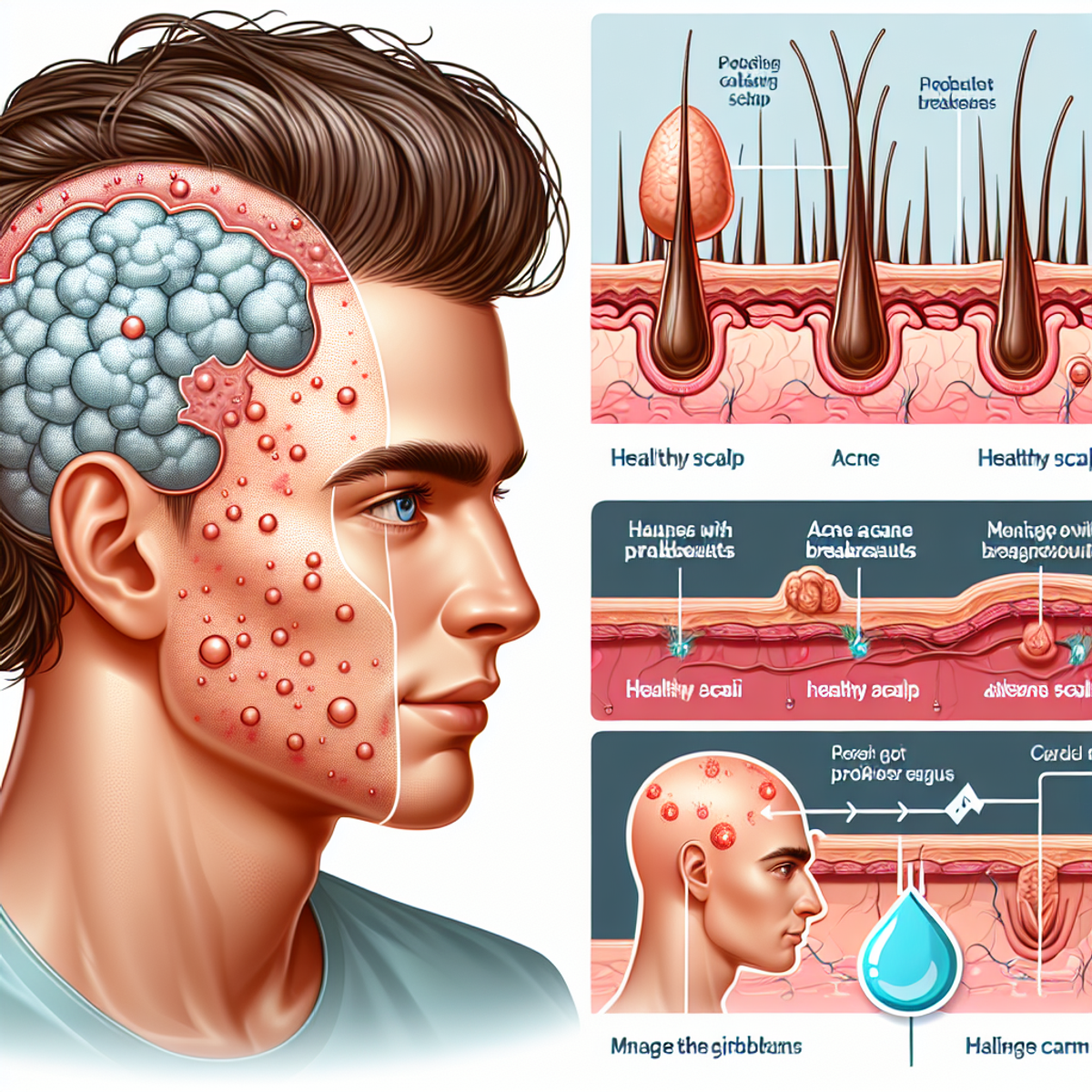Scalp Acne Breakouts Can Be a Pain — Here’s How to Manage Them

Introduction
Scalp acne breakouts can be a frustrating and uncomfortable condition that affects many individuals. These outbreaks of zits, whiteheads, or pustules on the scalp can significantly impact a person’s quality of life, causing embarrassment and discomfort.
In this article, we will explore:
- The causes of scalp acne breakouts
- The symptoms of scalp acne breakouts
- The treatment options for scalp acne breakouts
- Preventive measures for scalp acne breakouts
- When to seek medical attention for scalp acne breakouts
By equipping readers with this knowledge, we aim to help them effectively manage this condition and regain their confidence.
Causes of Scalp Acne Breakouts
Scalp acne breakouts, also known as scalp pimples, can be triggered by various factors, leading to discomfort and potential self-esteem issues. Understanding the causes behind these breakouts is crucial for effective management and prevention. Here, we will explore the different factors that contribute to the development of scalp acne breakouts:
1. Clogged Hair Follicles
The accumulation of oil, dead skin cells, and other debris can clog hair follicles, creating an ideal environment for acne-causing bacteria to thrive. This can lead to the formation of scalp acne breakouts. According to the National Institute of Arthritis and Musculoskeletal and Skin Diseases (NIAMS), clogged hair follicles are a primary cause of acne.
2. Role of Hair Products and Microorganisms
Certain hair products, such as heavy conditioners or styling gels, can contribute to clogged pores and follicles, exacerbating scalp acne breakouts. Additionally, microorganisms like Propionibacterium acnes (P. acnes) can play a role in triggering inflammation and acne development on the scalp. Research published in the National Center for Biotechnology Information (NCBI) highlights the association between hair product use and acne.
3. Excess Sweat/Oil/Dead Skin Cells and Sebum Imbalance
Factors such as excess sweat, oil production, and dead skin cells can contribute to pore blockages and the development of scalp acne breakouts. Imbalances in sebum production, which is responsible for lubricating the skin and hair, can further aggravate this condition.
4. Hormone Fluctuations
Hormonal changes, particularly an increase in androgen levels, can stimulate the sebaceous glands to produce more oil. This excess oil production can contribute to clogged pores and serve as a breeding ground for acne-causing bacteria. The Cleveland Clinic explains the connection between hormone fluctuations and acne breakouts.
5. Friction from Hats/Helmets/Headbands
Constant friction or pressure on the scalp from items like hats, helmets, or headbands can irritate the skin and potentially lead to the development of scalp acne breakouts.
6. External Factors such as Stress, Genetic Traits, and Medication Reactions
Stress has been linked to increased sebum production, potentially exacerbating scalp acne breakouts. Genetic predispositions may also play a role in an individual’s susceptibility to this condition. Furthermore, certain medications or cosmetic products may trigger adverse reactions in some individuals, leading to scalp acne breakouts.
By understanding these underlying causes, individuals can take proactive measures to manage and prevent scalp acne breakouts effectively. In the following sections, we will delve into identifying symptoms of scalp acne breakouts and discuss comprehensive approaches for treatment and prevention.
Symptoms and Identification
Dealing with scalp acne breakouts can be uncomfortable and frustrating. To effectively manage this condition, it is important to be able to identify the symptoms. Here are some common symptoms of scalp acne breakouts that you should look out for:
- Tiny bumps: One of the most noticeable symptoms of scalp acne breakouts is the presence of small, red or flesh-colored bumps on the scalp or hairline. These bumps can be tender to the touch and may be filled with pus.
- Whiteheads: Another common symptom is the appearance of whiteheads on the scalp or along the hairline. These whiteheads are typically small, raised, and may have a white or yellowish center.
- Painful bumps: In some cases, scalp acne breakouts can cause larger, more painful bumps to form. These bumps may be filled with pus and can be particularly uncomfortable.
It is important to note that these symptoms can vary from person to person. Some individuals may only experience one or two of these symptoms, while others may have a combination of all three.
To help readers better understand these symptoms, visual references such as images or diagrams can be provided. These visuals can aid in the recognition of scalp acne breakouts and help individuals distinguish them from other conditions that may have similar symptoms.
By being able to identify these symptoms, individuals can take appropriate action to manage their scalp acne breakouts effectively. This knowledge allows them to seek out the right treatments and preventive measures that will help alleviate their symptoms and improve their overall quality of life.
It’s worth noting that while scalp acne can be uncomfortable, it’s generally not dangerous like skin cancer. However, if you notice any suspicious moles or spots on your scalp, it’s always a good idea to have them checked out by a dermatologist.
Managing Scalp Acne Breakouts: Treatment and Prevention
Dealing with scalp acne breakouts can be frustrating, but there are ways to effectively manage this condition. Through a combination of medical treatments and healthy habits, you can take control of your scalp acne and improve your overall skin health.
Treatment Options for Scalp Acne Breakouts
There are several ways to treat scalp acne breakouts, but it’s important to remember that what works for one person may not work for another. It may take some trial and error to find the right treatment for you. Here are some common options:
- Medicated shampoos: These shampoos contain active ingredients like salicylic acid or benzoyl peroxide, which help unclog hair follicles and reduce inflammation. Using them regularly can keep your scalp clean and prevent future breakouts.
- Topical ointments: Prescription-strength ointments such as retinoids or antibiotics can be applied directly to the affected areas on your scalp. They work by reducing inflammation, killing bacteria, and promoting cell turnover.
- Antibiotics: In severe cases, a dermatologist may prescribe oral antibiotics to control the bacteria on your scalp and reduce inflammation. It’s important to follow their instructions and complete the full course of antibiotics.
- Alternative remedies: Some people find relief from treatments like phototherapy (light therapy) or antihistamines. Phototherapy involves exposing your scalp to specific wavelengths of light to reduce inflammation and kill bacteria. Antihistamines can help control itching and inflammation associated with scalp acne breakouts.
Lifestyle Changes for Scalp Acne Breakout Management
Alongside medical treatments, making certain lifestyle changes can also help prevent scalp acne breakouts and improve the overall health of your scalp. Here are some tips to consider:
- Regular hair washing: Wash your hair regularly, especially after exercising or sweating. This helps remove excess oil, sweat, and dirt from your scalp, preventing clogged pores.
- Minimal use of hair products: Avoid using excessive amounts of hair products, as they can contribute to clogged hair follicles. When using styling products, choose non-comedogenic or oil-free options.
- Looser headgear: If you often wear hats, helmets, or headbands, make sure they are not too tight or restrictive. Tight-fitting headgear can trap sweat and oil on your scalp, leading to breakouts.
- Skin-healthy diet: A balanced diet rich in fruits, vegetables, lean proteins, and whole grains can promote healthy skin. Avoiding excessive sugar and processed foods may also help reduce inflammation.
Taking a Holistic Approach
Managing scalp acne breakouts is a holistic process that requires both medical intervention and lifestyle adjustments. Here are some key points to remember:
- It’s important to be patient and consistent with your treatment plan to see results.
- If you’re unsure about which treatment options or lifestyle changes are best for you, consult with a dermatologist who can provide personalized advice based on your specific needs.
- By taking a comprehensive approach to managing scalp acne breakouts, which includes alternative remedies and making positive changes in your daily routine, you can effectively control this condition and improve the health of your scalp
Knowing When to Seek Medical Attention
When it comes to managing scalp acne breakouts, it’s essential to be mindful of the signs that may indicate the need for medical attention. While many cases of scalp acne can be effectively managed with self-care measures and over-the-counter treatments, there are certain red flags that should prompt individuals to seek specialized care from a dermatologist.
Red Flags for Seeking Medical Intervention
- Worsening Condition: If you notice that your scalp acne breakouts are becoming increasingly severe or persistent despite your efforts to manage them, it may be time to consult a dermatologist. A worsening condition could indicate that the underlying causes of your scalp acne require professional evaluation and targeted treatment.
- Lack of Improvement After Six Weeks: In most cases, consistent and diligent application of self-care measures and over-the-counter treatments should lead to visible improvement in scalp acne breakouts within a few weeks. If you find that your condition is not getting better or is even getting worse after six weeks of such efforts, seeking medical attention is advisable.
- Presence of Severe Pain/Swelling: Scalp acne breakouts can sometimes lead to discomfort, tenderness, or swelling in the affected areas. If you experience intense pain or notice significant swelling associated with your scalp acne, it’s important to have these symptoms evaluated by a dermatologist.
Empowering Informed Decision-Making
By understanding these red flags and being aware of when it’s appropriate to seek medical attention for scalp acne breakouts, individuals can make informed decisions about their healthcare. Consulting a dermatologist can provide access to personalized treatment options that target the specific causes and characteristics of the scalp acne, leading to more effective management and better outcomes.
Remember that seeking medical attention for scalp acne breakouts is not an indication of failure in self-care efforts but rather a proactive step towards addressing the condition comprehensively. Dermatologists can offer valuable insights, prescribe specialized treatments, and guide individuals in developing a tailored approach to managing scalp acne breakouts based on their unique needs.
Being attentive to these red flags and seeking timely medical intervention when necessary can contribute significantly to the effective management of scalp acne breakouts, ultimately promoting skin health and overall well-being.
Conclusion
Managing scalp acne breakouts requires a comprehensive approach that combines both medical advice and healthy lifestyle habits. By understanding the causes, symptoms, treatment options, and preventive measures discussed in this article, you can effectively take control of your condition and regain your confidence and quality of life.
Here are the key takeaways:
- Comprehensive Approach: Managing scalp acne breakouts involves addressing both the underlying causes and treating the symptoms. By adopting a holistic approach that combines medical treatments with lifestyle modifications, you can achieve better results.
- Take Action: Don’t let scalp acne breakouts hold you back. Implement the treatment and prevention strategies discussed in this article. Regularly wash your hair after exercise, minimize the use of hair products, and consider looser headgear to reduce friction on your scalp.
- Consult a Dermatologist: If your condition worsens or does not improve after six weeks of self-care measures, it may be time to seek professional help from a dermatologist. They can provide personalized treatment recommendations based on your specific needs.
Remember, managing scalp acne breakouts is a journey that requires patience and persistence. With the right care and guidance, you can successfully control this condition and enjoy healthier skin. Don’t hesitate to take action and prioritize your well-being.










